Ap biology macromolecules - Study guides, Class notes & Summaries
Looking for the best study guides, study notes and summaries about Ap biology macromolecules? On this page you'll find 82 study documents about Ap biology macromolecules.
Page 4 out of 82 results
Sort by
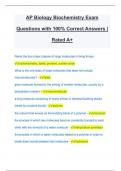
-
AP Biology Biochemistry Exam Questions with 100% Correct Answers | Rated A+
- Exam (elaborations) • 10 pages • 2024
- Available in package deal
-
- $9.99
- + learn more
AP Biology Biochemistry Exam Questions with 100% Correct Answers | Rated A+ Name the four major classes of large molecules in living things - carbohydrates, lipids, proteins, nucleic acids What is the one class of large molecules that does not include macromolecules? - lipids giant molecule formed by the joining of smaller molecules, usually by a dehydration reaction - macromolecule a long molecule consisting of many similar or identical building blocks linked by covalent bonds - polym...
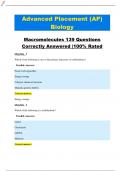
-
ADVANCED PLACEMENT (AP) BIOLOGY MACROMOLECULES 139 QUESTIONS CORRECTLY ANSWERED |100% RATED
- Exam (elaborations) • 59 pages • 2024
-
Available in package deal
-
- $11.00
- + learn more
Question 1 Which of the following is one of the primary functions of carbohydrates? Possible Answers: Protect cell organelles Energy storage Catalyze chemical reactions Maintain genetic fidelity Correct answer: Energy storage Question 2 Which of the following is a carbohydrate? Possible Answers: Lipase Cholesterol miRNA Mannose Correct answer: EXAM Mannose Question 3 Beta amylase is an enzyme that breaks down polysaccharides into component monosaccharides, but is not produced by humans. Beta...

-
AP Biology Exam FRQ's (Unit 1)
- Exam (elaborations) • 3 pages • 2024
- Available in package deal
-
- $9.59
- + learn more
AP Biology Exam FRQ's (Unit 1) Describe the role of carbon in biological systems. Carbon is used to build biological macromolecules such as carbohydrates, proteins, nucleic acids, and lipids. (Unit 1) Explain how, when the membranes are fused, the polar parts of the phospholipids from one cell will interact with the phospholipids from the other cell and how the nonpolar parts of the phospholipids from one cell will interact with the phospholipids from the other cell. When the membranes ...
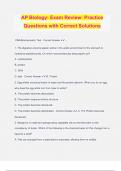
-
AP Biology: Exam Review: Practice Questions with Correct Solutions
- Exam (elaborations) • 83 pages • 2024
-
- $14.49
- + learn more
AP Biology: Exam Review: Practice Questions with Correct Solutions DNA/Biochemestry Test - Correct Answer ️️ --- 1. The digestive enzyme pepsin works in the acidic environment of the stomach to hydrolyze peptide bonds. On which macromolecules does pepsin act? A. carbohydrate B. protein C. DNA D. lipid - Correct Answer ️️ -B. Protein 2. Egg whites consist primarily of water and the protein albumin. When you fry an egg, why does the egg white turn from clear to white? A. The pro...
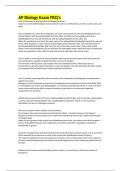
-
AP Biology Exam FRQ's (Unit 1)
- Exam (elaborations) • 3 pages • 2024
-
- $10.39
- + learn more
AP Biology Exam FRQ's (Unit 1) Describe the role of carbon in biological systems. Carbon is used to build biological macromolecules such as carbohydrates, proteins, nucleic acids, and lipids. (Unit 1) Explain how, when the membranes are fused, the polar parts of the phospholipids from one cell will interact with the phospholipids from the other cell and how the nonpolar parts of the phospholipids from one cell will interact with the phospholipids from the other cell. When the membranes ...
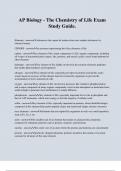
-
AP Biology - The Chemistry of Life Exam Study Guide.
- Exam (elaborations) • 8 pages • 2024
- Available in package deal
-
- $11.49
- + learn more
AP Biology - The Chemistry of Life Exam Study Guide. Elements - answersubstances that cannot be broken down into simpler substances by chemical means CHNOPS - answeran acronym representing the 6 key elements of life carbon - answerkey element of life; major component of ALL organic compounds, including all 4 types of macromolecules (sugars, fats, proteins, and nucleic acids); rarely found unbound to other elements hydrogen - answerkey element of life, highly involved in the creation of p...
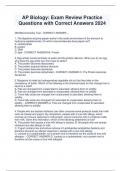
-
AP Biology: Exam Review Practice Questions with Correct Answers 2024
- Exam (elaborations) • 46 pages • 2024
- Available in package deal
-
- $17.99
- + learn more
AP Biology: Exam Review Practice Questions with Correct Answers 2024 DNA/Biochemestry Test - CORRECT ANSWER--- 1. The digestive enzyme pepsin works in the acidic environment of the stomach to hydrolyze peptide bonds. On which macromolecules does pepsin act? A. carbohydrate B. protein C. DNA D. lipid - CORRECT ANSWER-B. Protein 2. Egg whites consist primarily of water and the protein albumin. When you fry an egg, why does the egg white turn from clear to white? A. The protein bec...

-
AP Biology - The Chemistry of Life Questions and Answers | 100% Pass
- Exam (elaborations) • 14 pages • 2024
- Available in package deal
-
- $9.99
- + learn more
AP Biology - The Chemistry of Life Questions and Answers | 100% Pass elements - Answer️️ -substances that cannot be broken down into simpler substances by chemical means CHNOPS - Answer️️ -an acronym representing the 6 key elements of life carbon - Answer️️ -key element of life; major component of ALL organic compounds, including all 4 types of macromolecules (sugars, fats, proteins, and nucleic acids); rarely found unbound to other elements hydrogen - Answer️️ -key eleme...

-
AP Biology Biochemistry Exam Study Guide with Complete Solutions
- Exam (elaborations) • 9 pages • 2024
- Available in package deal
-
- $9.99
- + learn more
AP Biology Biochemistry Exam Study Guide with Complete Solutions carbohydrates, lipids, proteins, nucleic acids - Answer️️ -Name the four major classes of large molecules in living things lipids - Answer️️ -What is the one class of large molecules that does not include macromolecules? macromolecule - Answer️️ -giant molecule formed by the joining of smaller molecules, usually by a dehydration reaction polymer - Answer️️ -a long molecule consisting of many similar or ident...

-
AP Biology - Unit 2 Study Guide with Complete Solutions
- Exam (elaborations) • 15 pages • 2024
- Available in package deal
-
- $9.99
- + learn more
AP Biology - Unit 2 Study Guide with Complete Solutions List the differences between a prokaryotic & a eukaryotic cell. - Answer️️ -Eukaryotic Cell: - nucleus (has more DNA) that's bound by a double membrane - endomembrane organelles in the cytosol (nuclear envelope, endoplasmic reticulum, Golgi apparatus, lysosomes, plasma membrane, various types of vesicles & vacuoles) - typically larger Prokaryotic Cell: - no nucleus, but has DNA (circular chromosome) that is concentrated in the...

$6.50 for your textbook summary multiplied by 100 fellow students... Do the math: that's a lot of money! Don't be a thief of your own wallet and start uploading yours now. Discover all about earning on Stuvia


